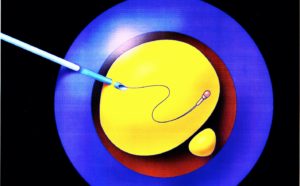IVF & ICSI: Is Less Actually More?

It is the single biggest advance in fertility technology since in vitro fertilization (IVF) was developed 40 years ago. It helps men with even the most severe forms of infertility to father children. It allows human eggs to begin life when they would not have otherwise done so. And it’s used in the vast majority of cases of IVF nowadays. But what has taken the fertility industry by storm started out as a lab error. It also bypasses natural selection as we know it. Welcome to the world of single sperm injection or intracytoplasmic sperm injection (ICSI).
Double-Edged Sword
ICSI was born from the need to enable men with male infertility and low sperm counts to conceive. IVF requires a few million sperm to “bath” eggs in a dish. But if fewer sperm are available, IVF won’t work. Adding ICSI to IVF reduces the sperm requirement to 1 sperm per egg, as a single sperm is injected directly into the egg. Notably, with IVF, nature still chooses the best sperm for fertilization, but with ICSI a laboratory embryologist chooses the sperm. I’ve always wondered whether we are as good as God or Darwin at selecting the right sperm. We know natural selection, developed through millions of years of evolution, is altered with ICSI, and in ways that are entirely unclear to us. So, although ICSI is a powerful sword, it is also a double edged one. It is, in a word, somewhat “unnatural.”
ICSI Overkill?
ICSI began as a tool to help men with male infertility, which is about 15% of IVF cases. Lately, however, it has been used in the vast majority (75%) of IVF cases and for reasons entirely unrelated to male infertility. Is our encroachment into nature’s turf warranted? Is ICSI really helping us conceive better than IVF alone?
Recently, a study was done in Australia to examine this issue. Researchers looked at 3363 IVF cycles over a 6-year period that were undertaken in couples without any male factor infertility. That means that the male partners had normal semen analyses. But ICSI was used along with IVF anyway. They then compared the outcomes of couples who used IVF and those who underwent IVF-ICSI. By all measures of success, the couples receiving IVF did better. This includes fertilization rates (5% better), pregnancy rates (6% better) and live birth rates (4% better). Although these differences appear small, they are highly clinically and statistically significant. In fact, the authors concluded that “this translates to 1 less pregnancy for every 15 cycles where ICSI was used without [a] clear indication.” So, the addition of more technology led to less fertility success.
So, what’s the lesson? Nature has been tweaking reproduction over millions of years and it’s quite good at it. Maybe we shouldn’t assume that our newly developed technology is better than nature in all cases. Maybe we should use fertility technology only when we really need it and go more “organic” with fertility treatments!









